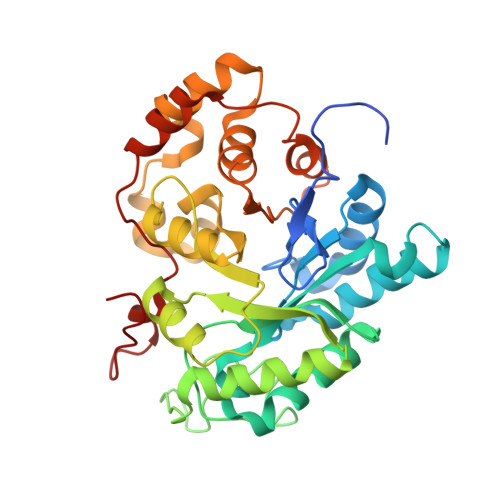Crystal structure of yeast xylose reductase in complex with a novel NADP-DTT adduct provides insights into substrate recognition and catalysis.
Paidimuddala, B., Mohapatra, S.B., Gummadi, S.N., Manoj, N.(2018) FEBS J 285: 4445-4464
- PubMed: 30269423
- DOI: https://doi.org/10.1111/febs.14667
- Primary Citation of Related Structures:
5ZCI, 5ZCM - PubMed Abstract:
Aldose reductases (ARs) belonging to the aldo-keto reductase (AKR) superfamily catalyze the conversion of carbonyl substrates into their respective alcohols. Here we report the crystal structures of the yeast Debaryomyces nepalensis xylose reductase (DnXR, AKR2B10) in the apo form and as a ternary complex with a novel NADP-DTT adduct. Xylose reductase, a key enzyme in the conversion of xylose to xylitol, has several industrial applications. The enzyme displayed the highest catalytic efficiency for l-threose (138 ¡À 7 mm -1 ¡¤s -1 ) followed by d-erythrose (30 ¡À 3 mm -1 ¡¤s -1 ). The crystal structure of the complex reveals a covalent linkage between the C4N atom of the nicotinamide ring of the cosubstrate and the S1 sulfur atom of DTT and provides the first structural evidence for a protein mediated NADP-low-molecular-mass thiol adduct. We hypothesize that the formation of the adduct is facilitated by an in-crystallo Michael addition of the DTT thiolate to the specific conformation of bound NADPH in the active site of DnXR. The interactions between DTT, a four-carbon sugar alcohol analog, and the enzyme are representative of a near-cognate product ternary complex and provide significant insights into the structural basis of aldose binding and specificity and the catalytic mechanism of ARs. DATABASE: Structural data are available in the PDB under the accession numbers 5ZCI and 5ZCM.
Organizational Affiliation:
Applied and Industrial Microbiology Laboratory, Department of Biotechnology, Bhupat and Jyoti Mehta School of Biosciences, Indian Institute of Technology Madras, Chennai, India.
















